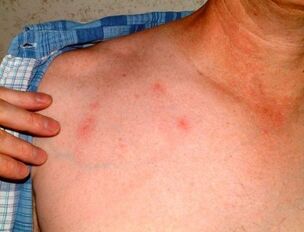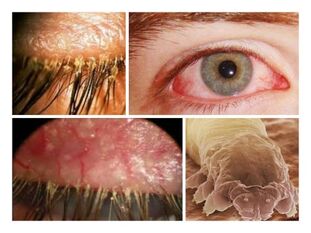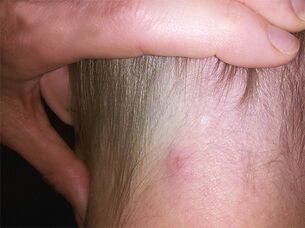
Photos and videos of subcutaneous parasitic symptoms in humans are not a pleasant sight. Unlike intestinal worms, which may be unknown to a person, epithelial infections are easy to spot. In this case, a person feels constant discomfort due to the symptoms that accompany the lesion. This helps to start the diagnosis of the disease and start treatment as early as possible. Photos of subcutaneous parasites in humans evoke almost disgusting emotions, but the symptoms of infection are much more unpleasant. The picture does not convey one’s sensation from the realization that one is crawling along his body. But epithelial infections are not only uncomfortable, but also a great danger to the health of the whole organism. Toxins secreted by parasitic bodies can affect all organ systems, and helminths themselves like to spread throughout the human body. So the manifestation of dermatological problems can be a sign of danger to the patient's life due to the presence of helminths in the brain, vision organs or heart.
What parasites live on the skin?
Dermatological problems can cause many types of infections. If, during intestinal infections, the presence of worms is most often diagnosed, then insects and protozoa can also be found under the skin. Mosquitoes, lice and other blood-sucking parasites usually feed unnoticed and escape from humans, but some survive and multiply in the body.
Each type of infection has its own way of entering the human body. Symptoms and effects of infection also vary. Therefore, the treatment of this disease will be done in different ways. But to distinguish one parasitic infection from another and to determine who lives in the body, it is necessary to undergo a lengthy diagnosis. Doctors, knowing the characteristics and habitats of different parasites, will tell you the most likely options before the start of the test, focusing only on the symptoms and travel maps of patients around the world.
Parasitic microorganisms
The most common disease like this is leishmaniasis. It is caused by the simplest parasite, which names the pathology. 9 out of 10 infections occur in only a few countries:

- Syria;
- Iran;
- Saudi Arabia;
- Afghanistan;
- Peru;
- Brazil.
The disease is spread by mosquitoes and some species of flies. Pathogenic microorganisms do not survive in temperate climates, so you can only be infected with leishmaniasis after resting in hot countries with tropical climates.
When infected, the infection forms an abscess at the site of the insect bite. Over time, it heals and leaves scars untidy. With various foci, leishmaniasis may look like leprosy. The danger of this disease is that it moves from the skin to the lymphatic system and can affect internal organs, gradually destroying them. At the same time, parasites live in cells, so the immune system is very useless to fight protozoa. But after one experience of fighting leishmaniasis, immunity is formed.
Insects among subcutaneous parasites
The disease caused by such aggression is called entomosis. There are several types of these subcutaneous parasites in humans:
- Sarcopsillosis (tungiasis).Called by tropical sand lice. Just walk barefoot on the beach or lie down in the sun so that the insect crawls to the body. It hides under the outer layer of the epithelium until blood is drunk. Then the fleas "become fat" and begin to press on the surrounding tissue, causing discomfort. When dead, it is removed from the body with the skin peeling off. If this does not happen, the tissue can become infected and purulent.
- Dermatobiasis.South American human tusks inject larvae under human skin. When fully developed, they tear tissue and leave the body, leaving open wounds. In the event of damage to the eyelids and skin above the cartilage, health-threatening consequences are possible.
- Acariasis.This disease is caused by lice. The most famous is scabies, which lives and breeds under the skin, consuming its cells. Symptoms of scabies can be easily distinguished from itchy urticaria with filamentous strips - channels in the epithelium that are bitten by female parasites. Another mite, Demodex, causes dermatitis and baldness.

Often, insects that inhabit the human body live in southern countries, as their development requires a stable hot climate. But in some cases, it is enough to visit the sea in the summer to fight with subcutaneous parasites for several months.
Parasite ringworm and more
Subcutaneous worms in humans are not difficult to detect. They usually give their location in the same way as other infections - through redness, itching and burning. But in some cases, the epithelium is only a intermediate cessation, and the main development of pathology continues in the internal organs:
- Dirofilariasis.There are several types of these helminths. Some prefer to settle on internal organs, but some affect the skin and eyes. Parasitic larvae are carried by mosquitoes and are found in warm areas. The painful, tender and moving lump swells at the site of the lesion. It is not dangerous if the infection does not affect the organs of vision. But it requires surgery for treatment.
- Dracunculiasis.Rishta worms enter the body with water containing small crustaceans that keep the larvae in their stomachs. Through the intestine, helminths penetrate the abdominal cavity, where they mate and lay eggs in the muscle tissue in the joints and bones of the legs. When the new worms mature, the larvae penetrate the skin and appear. The only way to get rid of the burning sensation and pain is to put the limb in the water. Other methods to get rid of parasites that have settled in the body have not been found.
- Schistosomiasis.Not all worms under human skin get there with food. To be infected with schistosomes, simply swim in the fresh waters of tropical countries in South America, the Caribbean, Africa or Southeast Asia. Skin lesions resemble scabies and are accompanied by tingling. But after a while, the larvae enter deep into the body, after which the symptoms of the epithelium disappear and the next stage of the disease develops.
- Gnathostomosis.Humans are not the natural host for this parasite. Therefore, worms cannot reproduce in the body. Asian parasites, therefore, enter the body with thermally processed fish, frogs or birds. Larvae begin to migrate after a month. Moving under the skin, they cause itching, redness and pain. Appearance in the abdomen is accompanied by edema.

Once the first signs of helminths life appear under the skin, the patient should undergo an examination and begin treatment. Many parasites can worsen health conditions, including disability, if not removed in a timely manner.
Diagnostic procedure
Given the various parasites that live under human skin, there is no universal method that can help determine the cause of this disease. We must also not forget that insects and worms are not the only source of possible dermatological problems. Allergic reactions, fungal growths and bacterial infections tend to cause itching and dermatitis.
The first stage of finding parasites on human skin begins with examination. The doctor conducts a survey, examines the affected area, and asks for other symptoms. Therefore, he will be able to narrow the search area and in some cases, for example with dracunculiasis and dirofilariasis, immediately give treatment.
If physical examination does not help fully explain the picture, laboratory and hardware diagnostic methods are provided:
- Blood test.General analysis shows the body's reaction to infection. Therefore, experts can determine the nature of the disease. When conducting biochemistry, it is important to note the indicators of erythrocyte deposition rate and eosinophil content. If they increase, this means helminthiasis is very likely. ELISA analysis is the most accurate. This will help determine the presence of antibodies even the exact type of parasite, if present in the body.
- Dirty analysis.Many subcutaneous worms are initially located in the intestine. By examining the stool, you can find the worm eggs and begin treatment.
- Biopsy.Analysis of affected tissues, abscess contents and purulent blisters, swollen lymph nodes can also reveal a picture of the disease.
- Ultrasound, X-ray, CT and MRI.Various hardware methods to "scan" the body will help localize the source of infection under the skin and internal organs. In some cases, this is the only effective diagnostic method.

Some infections can only be diagnosed after treatment, when parasites are removed from under the skin.
Treatment of parasitic diseases
Depending on the type of parasite, doctors should use different methods to get rid of the infection:
- Microorganisms are easily destroyed by using antibiotics. It must be accompanied by symptomatic treatment.
- You can get rid of lice by using special ointments and tablets. At the same time, dermatobiasis can only be cured with surgery, removing larvae from under the skin.
- The method of treatment of helminthiasis directly depends on the type of parasite. So dirofilariasis is treated only with surgery. Antihelmetics will help get rid of the cystosome and intestinal parasites. And the treatment of dracunculiasis is not provided at all. One has to wait for the worms to leave the body on their own, and fight the symptoms: pain and inflammation.
However, it is necessary to undergo a full examination by a doctor and begin treatment under his guidance to ensure complete elimination of the parasite.






































